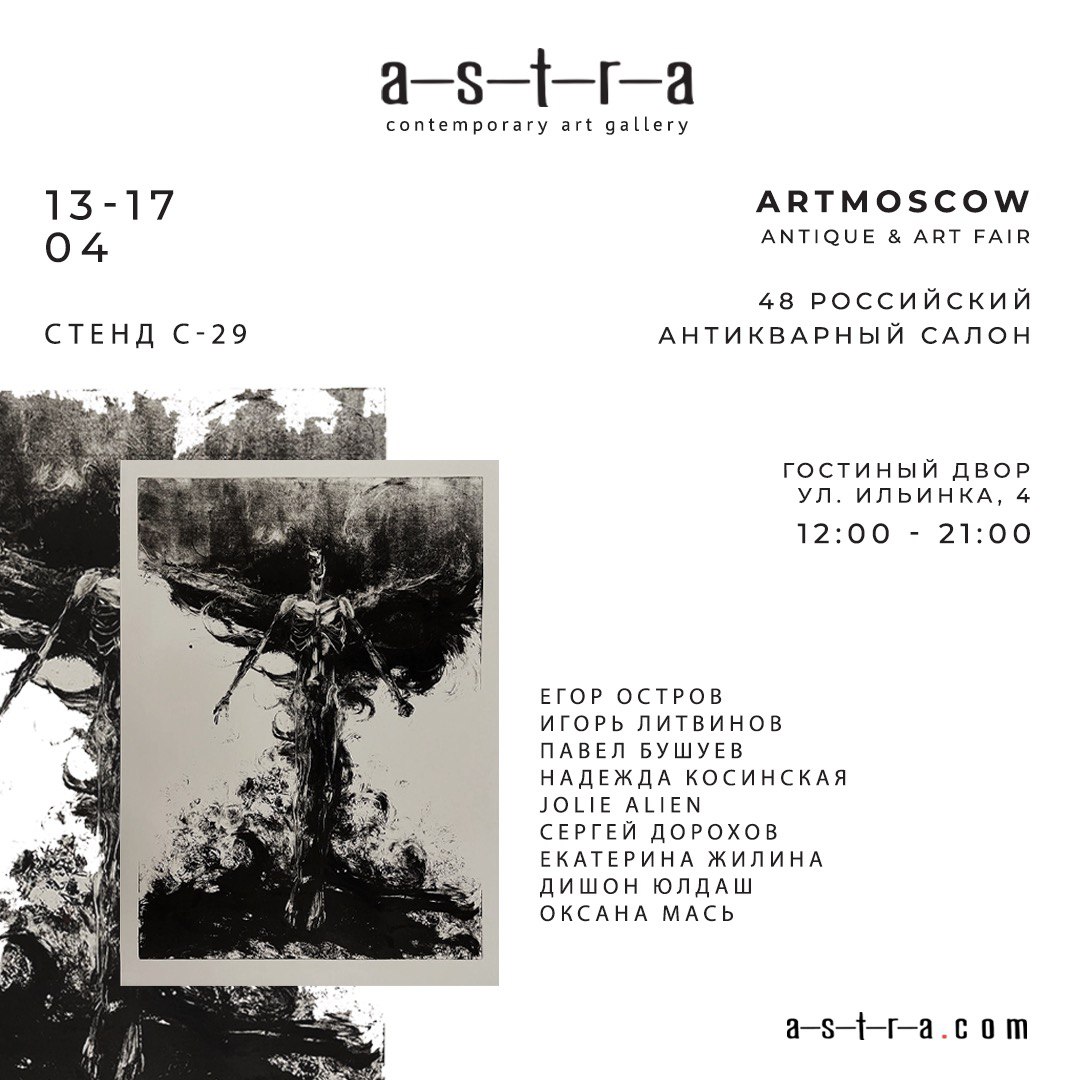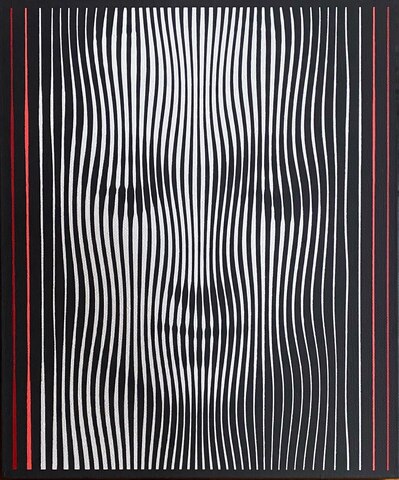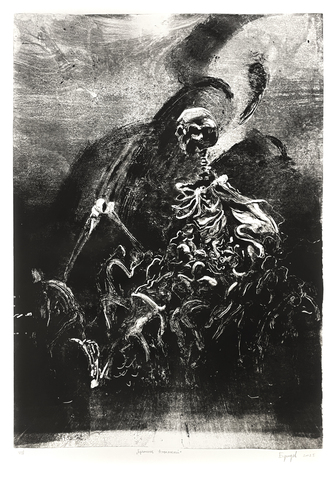АРТ МОСКВА 2022
a—s—t—r—a x 48 Russian Antique Salon
April 13 - 17, 2022
EGOR OSTROV, IGOR LITVINOV, OKSANA MAS, PAVEL BUSHUYEV, NADEZHDA KOSINSKAYA, SERGEI DOROKHOV, JOLIE ALIEN, EKATERINA ZHILINA AND DISHON YULDASH
booth C-29
Gostiny Dvor, Ilyinka 4
from 12 till 21.00

Ostrov Egor
Egor Ostrov is a third-generation artist, a descendant of the old-school academicians and iconoclasts of the 1960s. He thoughtfully defends the artistic legacy of the New Academy of Fine Arts (established in St. Petersburg in the early 1990s by Timur Novikov) regarding the preservation of the ideals of beauty and European tradition in art.
Egor Ostrov is a third-generation artist, a descendant of the old-school academicians and iconoclasts of the 1960s. He thoughtfully defends the artistic legacy of the New Academy of Fine Arts (established in St. Petersburg in the early 1990s by Timur Novikov) regarding the preservation of the ideals of beauty and European tradition in art.
By bringing back to life both the imagery and fundamental principles of neo-academicism and paying tribute to the greatest examples of classical art, with his works Egor Ostrov offers original visual interpretations of familiar compositions, while ‘reinventing’ them for the modern-day audience by using the latest achievements and cutting-edge technologies provided by contemporary science.
It is rather difficult to classify the works of Egor Ostrov. His creative method is unusual and unique. Not only does it require familiarity with world-known masterpieces of painting and sculpture, but also a deep insight into the structure and internal rhythm of each work. To achieve this, one should have the ability to delve into the very essence of the image, detect and emphasize precisely those qualities that make it a masterpiece, whether it is Michelangelo’s tangibility, El Greco’s spiritualism, Bernini’s baroque expression or Ingre’s grace.
At the heart of Egor Ostrov’s unique artistic technique is a linear raster brought by the artist to a fundamentally new level with the help of computer technology. The image is painted on canvas in the form of lines with various thicknesses and saturation. This results in a special optical effect revealing the physics of the eye and visual perception. This is the basic principle of engraving: the strips are structured as a strict sequence with varying levels of thickness, sharpness, and bend; they have their own beginning and end. However, if we talk about engraving as a classical mean of image reproduction, the Old Masters used to produce exquisite copies that still were bearing the impress if their style. In the works of Ostrov, images are being passed through a certain lens, they exist in the world of an optical illusion, and thus the original remains the original.
Such perfectionism allows combining the past and the future without any loss, expressing it in the present. The imagery of Egor Ostrov does not aim for a momentary aesthetic effect; it cannot be comprehended with a fleeting glance. According to Ostrov himself, the modern world is overloaded with images, and the artist’s task is to carefully consider the history of visual knowledge accumulated over the centuries, to understand their internal mechanism and infinite potential.
In this respect, each work of Egor Ostrov turns into a contemplative intellectual and visual dialogue, a kind of tribute to the works of the Old Masters. The images move and vibrate; the hypnotizing raster recreates them over and over, it changes their appearance and mood depending on distance and point of view.
The art of Egor Ostrov brings back the notion of the ideal into modern life that is full of technology, calculations, and worldwide networks. The artist’s work is the embodiment of mathematical beauty, combining absolute accuracy of lines, purity of forms and ideality of the image.
It is a new milestone in neo-academicism, its coexistence in the age of conceptual art’s predominance makes it a retrospective and refreshing phenomenon at the same time.
SELECTED GROUP AND SOLO SHOWS:
- 2022 — St. Petersburg Art Fair "1703", a—s—t—r—a gallery, Manezh Central Exhibition Hall, St. Petersburg
- 2022 — Art Moscow program within the framework of the 48th Russian atikvar Salon, a—s—t—r—a gallery. Gostiny dvor, Moscow
- 2021 — The State Hermitage Museum "Raphael Line. 1520-2020"
- 2021 — Art Moscow program within the framework of the 46th Russian atikvar Salon, a—s—t—r—a gallery. Gostiny dvor, Moscow
- 2020 — solo show a—s—t—r—a gallery, Cube, Moscow
- 2018 — Canon, Orekhov gallery, Moscow
- 2016 — Pontormo Book (together with Arkady Ippolitov)
- 2015 — Absolute Beauty – Neoacademism in Saint Petersburg. Ludwig Museum, Budapest
- 2014 — Selected. Transatlantiqe Gallery. Moscow
- 2012— In the Flow. ArtMost Galley. Mayfair, London
- 2011 — Immodern Art (with Elena Ulantseva) Knop’s Castle, Moscow
- 2011-2012 – New Academy. Ekaqterina Art Foundation. Moscow
- 2008 — String Theory. State Academy of Fine Art, Moscow
- 2007 — Sign and Image. Attelier No.2, Moscow
- 2007 — New Positive Process. State Center for Photography, Saint Petersburg
- 2007 — Image and Sign. D137 Gallery, Saint Petersburg
- 2004 — Depth of Field: Egor Ostrov and Arno Brecker. D137 Gallery, Saint Petersburg
- 2003 — The Snowqueen’s Way: Egor Ostrov and Belyaev Gintovt. New academy of Fine Arts, Saint Petersburg
- 2003 — New Academists. Look Art Gallery, London
- 2001-2002 – Beauty and Eritism. Gallery Gasunie, Groningen
- 2000 — Successors of Sparta. Synebruchoff Art Museum, Helsinki
- 1998 — Seven Lines to the Inch. Aidan Gallery, Moscow
- 1998 — Saint Petersburg Neoacademist Photography. Museum Foreign Art, Riga
- 1998 — New Possitive Processes. State Russian Museum State Hermitage, Saint Petersburg
- 1997 — Kabinet. Stedelijk Museum, Amsterdam
- 1996 — Metaphern des Entrucktseins. Aktuelle Kunst aus St. Petersburg. Badischer Kunstverein/Karlsruher Kunstlerhaus, Karlsruhe
- 1996 — Egor Ostrov: Paintings. Galerie Rotloff, Karlsruhe
- 1994-1995 — Self-Indetification: Positions in Saint Petersburg art from 1970 until today. Kiel, Berlin, Oslo, Sopot, Copenhagen, Saint Petersburg.
- 1994 — Renaissance and Resistance. State Russian Museum, Saint Petersburg
- 1994 — Achilles. New Academy of Fine Arts, Saint Petersburg
STRINGS OF OSTROV
"Egor Ostrov's style is a combination of two inexhaustible sources of elegance. It is the glamor of high-tech and the aristocratism of European painting from the Renaissance to the New Age. In the designer's gloss on the surfaces of his reflector paintings, the ethereal grandeur of images by Piero de la Francesco or El Greco shines through. “Madonna Misericordia” and ‘Deposition from the Cross’ glow an ethereal blue on canvases coated with phosphorescent dyes, like paintings of the universe glittering abstractly on the wings of an airliner. Ostrow's perfectionism as an artist, able to merge past and future on the present canvas without loss, is both his personal style and a manifestation of the historical milieu in which he became a dandy and the “new serious.” Of course, not everyone became a dandy at the turn of the Leningrad 1980-90s, but only those who heard within themselves the clear rhythm of the perfect city of St. Petersburg, free of Soviet power, deserted like the coast and left to itself. This rhythm is set by the proportions of architecture, embodied in the poetic word and in the anthropology of the city (from the Hermitage paintings to the bodily statics of the band Kino). And it translates one old philosophical truth: the beautiful is synonymous with the living, because the ugly is that which lacks a clear image and, therefore, exists as damage, is undead in the world. Consequently, the more perfect the image, the more actual, i.e. more effective and stronger the reality, whereas imperfection produces voids, holes-absorbers of energy and space. Philosophy shares the idea of beauty equally with art and the exact sciences. In mathematics - the basis of the latest technologies - it is the beautiful and elegant solution of a problem that is considered the most effective. Not surprisingly, the sharper the intellectual machinery of science, the more perfect plastic theories of the universe it forms. Ostrov is fascinated by the latest of these theories, string theory, which represents the elementary particles of the universe as vibrating, closed or open strings. String theory allows us to visually express the “networked” connections and interdependence of the world's patterns. It convinces that chaos is only one state of a self-structuring creative cosmos. In Ostrov's eyes there has always been such a linearly structured picture of the world - a picture of European engravings that captured the creative worlds of great artists with a network of strokes, in much the same way that, as a child, micro-fragments of these worlds were captured by the color raster of postage stamps. Over time, Ostrov began not only to see the graphic “nervous” framework of the image, but also to control its dynamics, to extract consonances or dissonances from the raster lines that accentuate the meaning of compositions. Ostrov's “String Band” combines the ancient voice of the Apollonian kyphara with the latest electronic sound, just as the latest physical theory of strings reminds us again of the insights of medieval mystics who, like Honorius of Augustodun, envisioned the universe as a full-sounding, harmoniously created zither."
Ekaterina Andreeva
SELECTED PUBLICATIONS:
Bushuev Pavel
From 2014 to 2017 he studied at the creative studios of the Russian Academy of Arts in St. Petersburg. His works are in the collections of the Fabergé Museum, BREUS Foudation, the private collection of the head of the Guerlain House and in other collections in Russia and abroad.
Born in 1987 in Kopeysk, Chelyabinsk region.
Graduated from the Chelyabinsk Art College (2007) and the graphic arts department (studio of Andrei Alekseevich Pakhomov) of the Repin St. Petersburg State Art Academy (2014). From 2014 to 2017 he trained in the creative workshops of the Russian Academy of Arts in St. Petersburg. During his studies he participated in exhibitions and competitions in Russia, Korea and China, cooperated with GOZNAK (Mint). Pavel's works are in the collections of the Fabergé Museum, BREUS Foundation, private collection of the head of the House of Guerlain, as well as in private collections of many countries, including Russia, France, Korea, USA and China.
In his works, Pavel captures the process of internal metamorphosis that takes place within a person while experiencing something that comes from the outside. Having received an academic art education, Paul continues to develop in various contemporary media, experimenting with artistic languages, however a large portion of his visual practice is black and white graphics. In his work, the artist often collides academic drawing with contemporary trends, exploring the boundaries of normality and subjectivity, reality and mysticism.
SELECTED EXHIBITIONS AND AWARDS:
- 2024 — KONTUR Graphics Fair, a—s—t—r—a gallery, Nizhny Novgorod
- 2023 — Fair |catalog|, a—s—t—r—a gallery, Moscow
- 2023 — St. Petersburg Art Fair “1703”, a—s—t—r—a gallery, Manezh, St. Petersburg
- 2023 — KONTUR Graphics Fair, a—s—t—r—a gallery, Nizhny Novgorod
- 2023 — Quiet Move. (Un)obvious art scene of St. Petersburg, a—s—t—r—a gallery, Winzavod, Moscow
- 2022 — blazar young art fair, a—s—t—r—a gallery, Moscow
- 2022 — Cosmoscow art fair, a—s—t—r—a gallery, Moscow
- 2022 — a-s-t-r-a Open.Vol 1, a—s—t—r—a gallery, Winzavod, Moscow
- 2022 — St. Petersburg art fair “1703”, a—s—t—r—a gallery, Manezh, St. Petersburg.
- 2022 — Collective self-fulfilling prophecy about our beautiful tomorrow, a—s—t—r—a gallery, Vinzavod, Moscow
- 2022 — Art Moscow program within the 48th Russian Atiquarian Salon, a—s—t—r—a gallery. Gostiny Dvor, Moscow
- 2021 — Group exhibition “12345 I go looking”, St. Petersburg, Russia
- 2021 — Cosmoscow art fair, a—s—t—r—a gallery, Moscow
- 2021 — Blazar, a—s—t—r—a gallery, Moscow
- 2021 — Art Moscow program within the framework of the 46th Russian antique salon, a-s-t-r-a gallery. Gostiny Dvor, Moscow
- 2021 — “Russian Shield”, St. Petersburg, Russia
- 2020 — Cosmoscow art fair, a—s—t—r—a gallery, Moscow, Russia
- 2019 — Art Event Suspense. Brakgausen Mansion, St. Petersburg, Russia *
- 2019 — ART Event Suspense.
- 2019 — ART Event Suspense 2.0. Port Sevkabel, St. Petersburg
- 2018 — Intervention. Hermitage Museum, Main Staff, St. Petersburg
- 2018 — International Fifth Biennial of Graphic Arts. Romania
- 2012 — International Art Exhibition. Beijing, China
- 2011 — 1st place in the competition for the design of the Olympic banknote
- 2010 — International Art Exhibition. Seoul, Korea
“Creativity must always be sincere in order to find its audience. Creativity is a constant search for its sides. It is the pleasure of discovery. It is the continuous dissatisfaction with what has already been done, as a sign that one must move on. Deformation (from Latin Deformatio - “distortion”) is a change in the mutual position of body particles, associated with their movement relative to each other. This series presents the deep deformations occurring inside a person. Perceptions of events, experiences and thoughts, as well as external factors pass through us, distorting the cognitive shell. The deformation is the fixation of these perceptions.”
Pavel Bushuev
FAVORITE PUBLICATIONS:
- Playbill - What to watch at the new contemporary art fair |catalog|
- Moscow Online - The a-s-t-r-a gallery hosted the opening of the group exhibition “Quiet Move. (Not) obvious art scene of St. Petersburg”
- Afisha Daily - Which exhibitions are worth going to in April 2023?
- Zhara Media - Pavel Bushuyev: “Being an artist is not a job, but rather a way of life”
- Buro. - “The Great Emptiness” and “Sunset in a Hundred and Forty Suns”: exhibitions visited in the past year and planned to see in 2024





